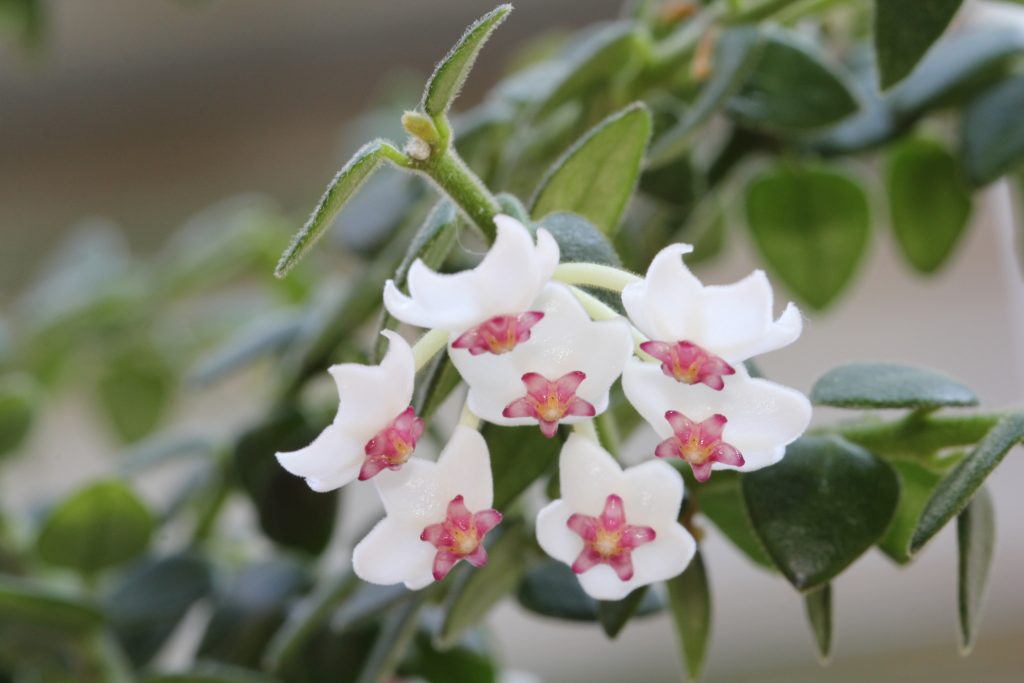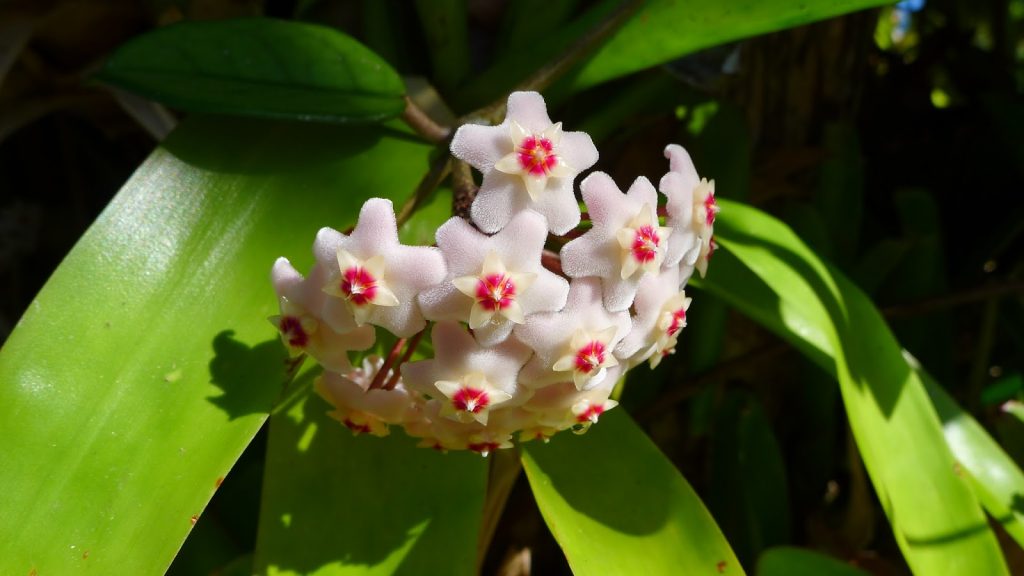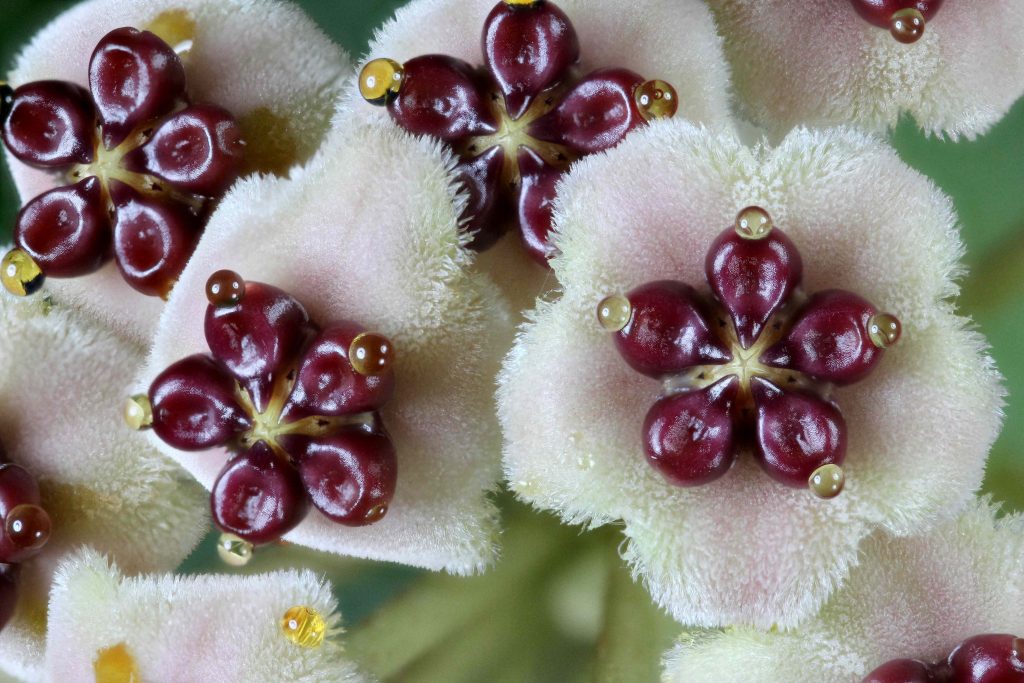Hoya Kerry - how to care for a flower
The evergreen hoya kerry is a tropical vine native to Polynesia, southern Asia and Australia. The plant got this name thanks to its discoverer - D. Kerry. In nature, there are several varieties of this ornamental culture, which are adapted for home growing conditions. Consider their description, rules of care and reproduction.

Hoya kerry variegata
general characteristics
Other names are green heart, Valentine, hoya in love.
In the flower description:
- stems are thin, light brown, lignified in adult plants, erect at first, then drooping;
- leaves are dense, fleshy, heart-shaped, multi-colored - emerald with beige stripes in the center or along the edges;
- length of the sheet plate - 15 cm;
- with good care, you can achieve colorful and long-lasting flowering - the buds are white, yellow or pink, depending on the variety;
Hoya blooms with small flowers in the form of stars, collected in dense umbrellas, size 1-2 cm, the color depends on the variety.
Flowering lasts from early June to late October. At the peak of decorativeness (July-September), the plant thins out a pleasant sweet aroma, reminiscent of the smell of vanilla or honey.
Varieties
There are several decorative varieties that are in great demand among flower growers.

Hoya kerry album
H. kerrii Variegata (Variegata) - in the center, the leaves are variegated (they do not participate in photosynthesis), along the edge they are green, and in the center there are pale yellow spots in the form of inclusions, stripes or strokes.
H. kerrii Albomarginata (Albomarginata). The leaves are medium in size - 7-8 cm long, 3-4 cm wide. They are saturated green with a light beige stripe contrasting along the edge.
H. kerrii Spot margin... The size of the sheet plate is 9-10x3-4cm. The color is green interspersed with a beige shade, contains a light yellow edging.
H. kerrii Spot center- the leaves are elongated. The main tone is green, closer to the center the color is more saturated, contains small specks or specks of yellow, gray, white tones.
H. kerrii Splash. A beautiful plant, a leaf plate of a rich green color with a silvery coating or small interspersed with a gray tone.
H. kerrii Spotted Leaves. Heart-shaped leaves of emerald color with a silvery speck, which gives the plant an original look.
Purchase and adaptation
You can buy such a flower in a specialized nursery or flower shop. When choosing a particular variety, pay attention to the condition of the crown. The stems should be free from growths, cracks, breaks and dry areas.

Hoya kerry bloom photo
The leaves are juicy, fresh, rich in color in accordance with the characteristics of the species. There are no yellow, black, red spots or holes on them.
It is also worth checking the substrate - if there is no mold, acidification and white bloom on it, then the root system is not damaged in any way.
After the purchase, it is not advisable to immediately place the flower among other vegetation, since there is a risk of infection with diseases or pests.
He is taken to a separate room, kept for 20 days to determine the condition. If infections are detected, they are treated with pesticides. For several weeks in quarantine, the hoya will be able to adapt to indoor growing conditions.
Landing rules
An ornamental tropical crop prefers to grow in a light, loose and nutritious substrate. You can prepare such a composition with your own hands - mix turf soil with peat, humus and sand in a ratio of 2: 1: 1: 1.
To better retain moisture in the soil, add a little crushed sphagnum moss to this mixture. For good moisture and breathability, you can use one handful of charcoal.
The variegated flower loves a lot of light, so it should be placed on the south or southwest window. Lighting should not be too bright, since the foliage quickly fade from direct sunlight and loses its original decorative effect.
When grown on a northern or eastern windowsill, the leaves become pale and monochromatic, so the crown will need to be additionally illuminated with a fluorescent lamp.
The necessary conditions
For full growth and flowering at home, a green heart flower requires several conditions.

Hoya kerry splash
Temperature
This plant from the tropics does not tolerate cold air, so at home it needs to be provided with stable heat - during the growing season (from spring to autumn) 22-25 ° C. In the winter season, they are kept cool at a temperature of 15-16 ° C. If the indicators are lower, massive yellowing and foliage begins to fall.
The room in which the flower grows should be regularly ventilated, since it loves fresh air very much. At this point, he is transferred to another place in order to prevent hypothermia in a draft.
Humidity
He loves high air humidity - within 75-80%, so the crown is irrigated every day in the warm season. Additionally, put an open container with water and place the flowerpot on a pallet with wet pebbles or expanded clay. In autumn and winter, this procedure is carried out once a week.
Sprinkling with warm water stimulates the growth of green mass, maintains decorative and cleanliness of the crown, and also prevents the appearance of parasites.
Illumination
A day requires 14-16 hours of diffused light. Therefore, the hoya is placed in the place where the sun shines in the morning and evening. In summer, it can be placed on a balcony, terrace or loggia protected from precipitation, winds and scorching rays.
In autumn and winter, when the day becomes shorter, artificial lighting is used. The device is installed at a distance of 50 cm from the crown.
Care requirements
The main care of Kerry's hoe at home is reduced to performing several activities - regular moistening, loosening, feeding and examination for damage by diseases and pests.

Hoya kerry photo care
Watering
The soil must be kept slightly damp. This plant does not tolerate excess moisture well - its root system begins to rot. Moisturize once a week in spring and summer. In the cold season - every 15 days. During the flowering phase, the frequency of watering is reduced, which has a positive effect on the quality of this process.
Use warm and settled water. After moistening, surface loosening is carried out, which helps to maintain the moisture and air permeability of the soil.
Top dressing
The best fertilizer for this flower is considered to be a complex composition for feeding cacti and succulents. Introduce throughout the entire period of growth and flowering - every two weeks.
In order to avoid burning the roots and to improve the quality of absorption of nutrients, all root dressings are combined with watering.
Pruning
Poorly tolerates this procedure, after which he may die. Therefore, pruning is carried out if you need to remove yellowed, dry, rotten leaves and stems.
To do this, use a disinfected and well-sharpened secateurs to minimize tissue trauma and prevent infection. Places of cuts are sprinkled with charcoal.
Also, do not cut off the peduncles after flowering, only dried flowers are removed. New buds will appear on the flower arrows next year.
Transfer
House flowers need regular transplantation:
- young - every 2 years;
- adults are transplanted every 3-4 years.
It is also necessary to transplant a purchased plant immediately after the end of flowering or a three-week quarantine (for non-flowering specimens). Take a plastic or ceramic flowerpot with holes in the bottom, it should be 2-3 cm larger in diameter of the previous pot. The roots are removed and, together with the earthen lump, are transferred into a new container, all voids are covered with fertile soil, moistened.
An unscheduled transplant is needed for a sick flower whose roots have rotted. The technique is as follows:
- hoya is watered abundantly to facilitate the extraction of roots and minimize the risk of injury;
- pulled out, dipped in a basin of water to wash off the remnants of the earth;
- dry the roots, cut out decayed places to healthy tissue;
- treated with a fungicide, after drying, they are planted in a new pot with a fresh and disinfected substrate.
Reproduction methods
At home, Hoya Kerry reproduces in several ways - each option has been tested and gives a positive result, provided that all the rules are followed.

Hoya kerry photo care at home
Cuttings
Cutting of planting material is carried out in spring or summer. Cut segments 15-20 cm long from the top of the stems. Each cutting should have 2-3 leaves and the same number of buds.
In the lower part, all the foliage is removed, dipped in a solution of Epin or Heteroauxin. Then it is slightly dried and planted in a loose mixture of peat and sand (1: 1). The depth of planting of cuttings is 3-4 cm. After planting, they are watered and placed in a warm place (temperature 23-25 ° C).
For quick rooting, the seedlings are regularly moistened. They can be covered with foil, but it is necessary to ventilate them every day. As soon as new leaves appear on the shoots, the shelter is removed. They are grown for another month so that they are overgrown with roots, then they are planted separately.
Stem layering
Choose the strongest and most flexible branch, make a 1 cm long section on it using a blade or a sharp knife. The injured area is covered with wet moss, then wrapped in foil. As soon as the roots break through the moss, the winding is removed, the stem is cut off from the mother flower, planted in a pot with fertile and loose soil.
Sheet
Such reproduction will require a lot of time and patience from you. Select several leaves on the stem, cut off with a blade along with the axillary bud. Dip in Kornevin's solution.
For planting, take seedling boxes or plastic containers, fill it with a peat-sand mixture. Deepen the leaves by 1 cm, moisten with warm water, cover with transparent glass. As soon as they start to grow (after about 1-2 weeks), the glass is removed. They continue to grow for 1.5-2 years. During this time, stems should grow near the leaves, after which you can plant them in separate pots.
Diseases and pests
At all stages of growth and development, this plant is exposed to the invasion of various parasites and infection. To prevent this, it is necessary to follow simple preventive measures and treat infected flowers in time.
| Diseases and pests | Signs | Treatment | Prophylaxis |
| Spider mite | Appears in conditions of low humidity and high temperature. Envelops the underside of the leaves, stems and internodes in small cobwebs.It feeds on their juice, which leads to yellowing, curling and drying | At the initial stage of the lesion, you can apply soap foam or a solution of laundry soap (50 g per 1 liter of water). If the flower is started, it is treated with Aktellik or Aktara twice with an interval of 7 days. | Increase the humidity, lower the temperature, regularly irrigate the crown with warm water |
| Shield | Small plaques of a red or brown tone prefer to feed on the juice of leaves, young stems, and buds. Black spots appear in places where the insect is parasitized. | First, unviable areas are cut out, then the crown and the soil under it are treated with Decis or Fitoverm twice with a frequency of 10 days | Plant in sterile soil, buy healthy specimens, regularly inspect for pests |
| Thrips | These parasites leave behind a sticky white coating, due to which the leaves and stems turn yellow and die off. The insect itself feeds on tissue juice, as a result, the leaf plate acquires a yellow tone, curls and dries | At the initial stage of infection, folk remedies are used - garlic and onion infusion (15 g of each substance in crushed form per 1 liter of water). All organs are washed, then covered with plastic wrap and left for a day. The launched form is treated with pesticides - Karbofos, Aktellik or Aktara | Regular irrigation of the crown, especially on hot days, will help prevent the appearance of a pest. |
| Aphid | It settles in colonies on the underside of the leaf plate, sucks out juices, which leads to wrinkling, drying out and falling off | Weakly damaged flowers are sprayed with ash and soap solution, infusion of garlic or tobacco. With a strong infection, irrigate the crown with Karbofos or Fitoverm | Monitor the condition of the substrate, loosen it regularly, avoid thickening between flowers. Buy healthy plants, wash the leaves and shoots with soapy water once a month |
| Root rot | Appears in hoya during frequent infusions. First, the root system rots, later the rot passes to the lower part of the stems - they soften, become covered with condensation, turn black | Such a flower is removed from the container, then they act according to the situation - if the entire root has rotted, it is thrown away, cutting off several shoots for rooting. In case of minor damage, only rotten roots are removed, then dipped in a fungicide solution for 2 hours, dried, sprinkled with charcoal. Are planted in sterile soil and a new pot | Adjust watering, use room temperature water to humidify |
| Sooty fungus | The predecessors of this sore can be aphids or thrips. They leave sticky excrement - the perfect environment for sore to develop. In places where mycelium is present, the flower becomes covered with a black bloom, then rots and dies | Treatment consists of several stages - first you need to destroy the insects that provoked the infection. After that, remove all damaged organs to healthy tissue, treat the crown and soil with antifungal drugs | Regularly carry out sanitary pruning, avoid thickening in a home flower garden, use calcined or spilled boiling water for planting, kill parasites that lead to infection in time |

